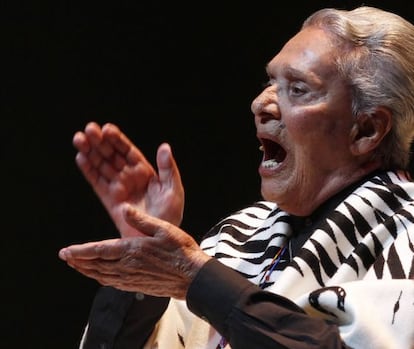Gutsy 'ranchera' singer who captured a world outside of Mexico dies at 93
Chavela Vargas made a courageous comeback after surviving alcoholism


Back in 1991, nobody in Mexico knew what had become of Chavela Vargas - "I think she died," many assumed. After her heyday in the 1960s, she dropped out of sight. But she hadn't died, only slipped down the slope of alcohol - from which, at last, she climbed back up with great effort.
But her songs were remembered; people were surprised that Almodóvar included her Piensa en mí (by Agustín Lara, of course, but there are singers who stake out their rights to certain songs) in his Tacones lejanos (High Heels), in a version by Luz Casal. There was no Chavela material in, for example, the record section of the Librería Gandhi, the indispensable general store for Mexico City's intelligentsia.
In 1992, a miracle occurred: "La Vargas" reappeared. She performed Fridays in El Hábito, a café-theater in Coyoacán that attracted, shall we say, a sexually tolerant public. There, Manuel Arroyo, of Turner Publicaciones, found her. The impression she made was striking, as he recounts in José Alfredo Jiménez. Cancionero completo : "They admired, no doubt, her courage in returning, even for a while, from her hell - something which, indeed, she had earned for herself, by pure courage. They admired, too, her proud, defiant air... They saw this, and perhaps other things, but not what mattered most: that the music she made every night, her way of singing each verse, so personal and so different from how others had done it, expressed a raw and intimate agony, a sort of self-sacrifice." Arroyo decided to re-launch the priestess.
At this point we can employ the usual biographies. The next year, 1993, Chavela appeared at the Sala Caracol in Madrid. The personality, the legend, was already consuming the artist. This could be appreciated in subsequent years, though this is not to deny the power of love for the legend: if you want to enjoy an electrifying performance, find En Carnegie Hall (2004).
In the process, Chavela was reduced to anecdotes, to her interaction with Frida, Diego, Pedro, Joaquín and Federico. It was never explained to us how so heterodox a woman had lived through the long decades of the PRI in Mexico, although María Cortina, in Las verdades de Chavela , (The truths about Chavela), Editorial Montesinos, suggests a more than comfortable situation: the role of a tolerated freak.
We know even less of her strategies as an artist, of how her LPs for Orfeón were prepared; most credits only mention guitarist Antonio Bribiesca. Chavela freed the ranchera from the corset of the mariachi genre, but some versions contain odd instrumental additions.
They made a mockery, a travesty, of Chavela. She was reduced to a symbol, an exemplary history, A Witness to the Age. They heaped honors and medals upon her, forgetting what made her unique. For the discerning listener, there remains the dissident pleasure of seeking out those recordings from the 1960s, with her voice at full power, sculpting indestructible songs. As a farewell, we must remember Tu recuerdo y yo . "They are already putting the last stirrup on me; I don't know at this moment if I still have faith. All I ask of you at this moment: play one more time the one by who is no longer here."
Tu suscripción se está usando en otro dispositivo
¿Quieres añadir otro usuario a tu suscripción?
Si continúas leyendo en este dispositivo, no se podrá leer en el otro.
FlechaTu suscripción se está usando en otro dispositivo y solo puedes acceder a EL PAÍS desde un dispositivo a la vez.
Si quieres compartir tu cuenta, cambia tu suscripción a la modalidad Premium, así podrás añadir otro usuario. Cada uno accederá con su propia cuenta de email, lo que os permitirá personalizar vuestra experiencia en EL PAÍS.
¿Tienes una suscripción de empresa? Accede aquí para contratar más cuentas.
En el caso de no saber quién está usando tu cuenta, te recomendamos cambiar tu contraseña aquí.
Si decides continuar compartiendo tu cuenta, este mensaje se mostrará en tu dispositivo y en el de la otra persona que está usando tu cuenta de forma indefinida, afectando a tu experiencia de lectura. Puedes consultar aquí los términos y condiciones de la suscripción digital.
Últimas noticias
Cubans look to Venezuela fearfully after Trump’s incursion: ‘We could be next’
The operation in Venezuela to capture Maduro threatens to widen the cracks in the MAGA movement
Trump clarifies who is ultimately in charge in Venezuela: ‘Me’
Maduro pleads not guilty before the federal court in New York: ‘I am still the president of Venezuela’
Most viewed
- Alain Aspect, Nobel laureate in physics: ‘Einstein was so smart that he would have had to recognize quantum entanglement’
- Gilles Lipovetsky: ‘If you want to live better and fall in love, take Prozac, don’t look to philosophy’
- Alvin Hellerstein, a 92-year-old judge appointed by Bill Clinton, to preside over Maduro’s trial in New York
- Cuba confirms death of 32 of its citizens in the US attack against Venezuela
- Why oil has been at the center of Venezuela-US conflicts for decades








































